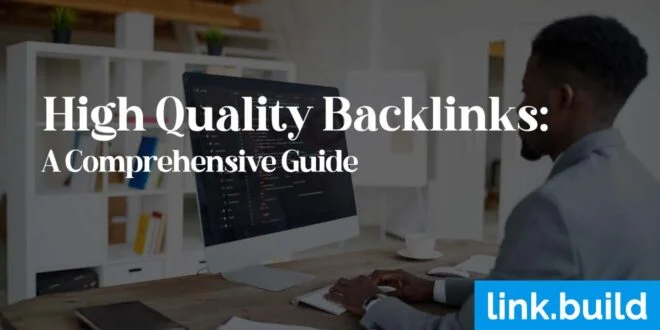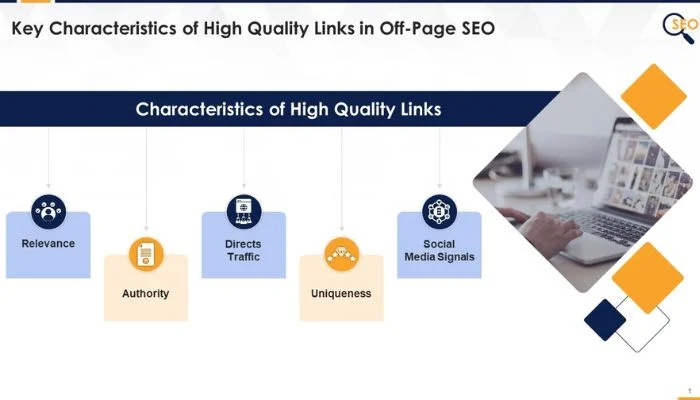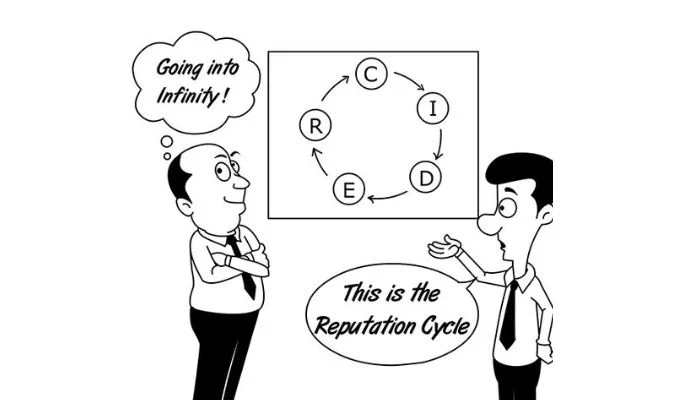High-Quality Backlinks: A Comprehensive Guide

Backlinks are one of the most important off-page SEO elements for ranking websites in search engines. They help increase website visibility, which is key to attracting more visitors and generating organic traffic from your target audience. It's not just about quantity when it comes to backlinks — quality matters too! High-quality links come from reputable sources like well-designed or authoritative sites that have relevant content related to yours.
In this comprehensive guide, you will learn all there is to know about high-quality backlinks for attracting links – what they look like and where you usually find them; how their characteristics can affect your rank; what benefits high quality pages get from a link building tactic aligned with these principles.
Last but not least we review a few techniques designed specifically to identify potential spots where such link-building efforts should be directed so webmasters cannot miss out on any opportunity presented by even the furthest corner of the Internet ocean as far as seeking opportunities for creating lasting relationships between different bloggers & page visitors.
Characteristics of High-Quality Backlinks

1. Relevance
Backlink relevance can be judged on two criteria: how closely related it is to your site's content and if other sites in that niche have already linked to you as well. Quality links also come from websites that are within a similar industry and cover topics that fit naturally with yours, building trust between customers looking at multiple sources regarding a single product or service offer.
Creating quality connections helps improve not only search engine rankings but user experience overall by subtly reassuring potential visitors your website contains valid information they rely upon when reaching out their decision-making process.
2. Authority
An authoritative link will generally come from a well-established and trusted source, such as an educational institution or government organization. These links have high value because they reflect positive credibility on your site, and they provide visitors with substantial resources for further information on topics related to your page's content.
Authority also denotes trustworthiness among internet users, which can both help convince customers that you are knowledgeable about what you offer and motivate them to take desired actions (purchase products/services).
3. Trustworthiness
Trustworthiness is one of the primary characteristics to look for when evaluating a backlink. It can be assessed by researching where the page link originates from and determining how well-established, reliable, or authoritative that source may be.
Go beyond simply assessing whether or not it's from Google; ask yourself if you would find this particular website credible in comparison to other sources on your topic. Quality over quantity should always prevail here, as having strong websites linking through often offers more SEO benefits than dozens of low-quality links with no authority whatsoever.
4. Anchor text

Anchor text is a type of link that works to direct readers (and search engine crawlers) from one webpage or web page element, such as an image or video, to another. It consists of the clickable words and phrases used in a backlink's hyperlinked form - like this website's name: Understanding High-Quality Backlinks – A Comprehensive Guide Here!
When choosing anchor texts for your own links, you should make sure they are relevant and descriptive. This helps users more easily understand where they will be taken after clicking on your links while also helping search engines properly index your site accurately by describing what content can be found when visiting those respective pages.
5. Contextual placement
Contextual placement is an important factor when determining high-quality backlinks. This refers to the surrounding content of where a link exists on that page relative to other nearby links and text.
The more relevant the anchor context appears within bodies of copy or navigation bars, the more it increases its value from both search engines and web visitors perspectives as readers are able to make sense out of clickable contexts in relation to the topic being discussed around them with better understanding.
Proper contextual placements also suggest relevancy for related searches made by users, which provides positive signals for SEO purposes.
6. Diversity
Training search engine algorithms to identify what constitutes a good link means having varied sources and types of linking content, ranging from guest blogging or resource links to social media shares. Having different root domains contributes towards reliable metrics like Domain Authority (DA).
By diversifying your site's portfolio through relevant blogs, forums, directories etc., it sends positive signals about trustworthiness which can lead to improved rankings on SERPs (Search Engine Result Pages) as well as increased brand visibility online.
In short, it matters less about how many links you have, but that the links are coming from multiple, different websites.
Sources of High-Quality Backlinks

1. Guest Blogging
Guest blogging is all about contributing valuable, engaging content to web pages that share the same topical authority as your brand or business. It requires research on websites within your industry and approaching a blog with high domain rankings in order to contribute articles regarding relevant topics for their readership.
This can be beneficial when it comes to naming yourself as an expert writer of certain subjects which has the potential impact website visitors wanting more from you—leading them straight back to your website!
2. Broken Link Building
Broken link building is an effective method of obtaining high-quality backlinks. It involves locating broken links on websites or blogs within your industry, then offering the webmaster resources to replace them with new content that you provide, and including a dofollow link in it.
This engages users by providing fresh data while also reinforcing credibility through citations from experts like yourself that can be found directly linking out to yours' website pages for further reference information. Since this process begins due to something wrong on their own online estate, most people are more accepting towards those who reach out empathically—building trust as well as SEO value at scale over time.
3. Infographics

Not only do infographics engage an audience visually, they can have external links embedded in them and shared on social media platforms like Twitter or Instagram driving traffic from those sites directly to yours.
By creating interesting visuals around your subject matter, with relevant content for the purpose of educating someone about what you're selling - then adding external links – you stand more chance of getting people interested enough to click through!
You should also make sure that link placement is appropriate within context so as not to set off any Google spam flags when submitted elsewhere online or linking across various domains.
4. Resource Link Building
Resource Link Building is a great way to obtain quality backlinks. It involves finding resources related to your own website and providing them with links that direct users toward additional information or products on your own page. This method can be used as both an external and internal link-building tool, as it helps get visitors from external sources while helping organize content within the same domain for easier navigation. In addition, this type of linking provides websites with valuable web traffic through increased visibility in search results, which ultimately leads to better rankings overall.
5. Social Media
With the immense reach and influence of social media, it offers an effective platform to build backlinks. Engaging the audience by sharing valuable content through resource pages or groups related to your niche builds credibility while also linking those contents with relevant resources in order to send users further down the sales funnel.
Platforms like LinkedIn present an excellent opportunity for building relationships with experts by using networking achievements, endorsements, and recommendations over time. From a technical standpoint as well, when looking at quality signals such as domain authority/trustworthiness of platforms where you acquire more links, it is important; major networks usually deliver good link value that is truly beneficial on expanding website rankings online!
How to Identify High-Quality Backlinks
1. Use of Link Metrics
To quickly identify high-quality backlinks, one of the most useful methods is to look at link metrics. These are measures such as domain authority and page authority that indicate how authoritative a website or webpage is in relation to its content.
Additionally, checking for metrics like MozRank can give you an indication of whether links from certain websites have been gaining popularity over time; this will help ensure any external link earned by your site comes with well-established trustworthiness. The higher these scores are, the more reliable those associated sites tend to be — indicating they could make powerful partners on a campaigns' SEO journey!
2. Conducting a Domain Analysis
Conducting a domain analysis is an important step in identifying high-quality backlinks. By examining factors such as the age of the website, page rankings, traffic sources, and whether or not it has any outbound links, you can assess a site's authority level on its given topics. If done correctly, this process will enable you, as a site owner, to spot potential red flags and avoid low-quality link partners, which could have negative impacts on your website.
3. Checking for Spam Signals
One of the most important practices for identifying high-quality backlinks is checking for spam signals. A link may look great on paper but could be part of a network that's low quality and involved in sketchy SEO tactics like keyword stuffing, or redirecting nonhuman traffic to links with poor authority metrics.
Spam backlink signal indicators include links coming from sites where you don't expect them, deals made between authoritative websites, and other suspicious behaviors related to page rank manipulation or too many outbound links relative to content consistency.
These signs point towards unnatural behavior, which should raise red flags when it comes time to find suspect sources during your search engine optimization efforts.
4. Assessing Traffic Sources
Determining the origins of a website's local and external inbound links can provide valuable insight into their reputation as well as the link-building strategies used to drive engagement from potential customers or users. Additionally, it allows you to gauge whether there are organic or paid sources driving visits from other relevant websites which may also have great relevance for your site's performance on search engine results pages (SERPs).
Benefits of High-Quality Backlinks
1. Improved Search Engine Rankings
High-quality backlinks are important for improved search engine rankings, as they act as signals of trust from one website to another. By having high-authority websites linked to your own site, you can increase your chances of appearing higher in organic search results and boost visibility on popular search engines such as Google or Yahoo. In turn, this will bring increased referral traffic directly through these links, along with a spike in brand awareness that could potentially lead to business growth over time.
2. Increased Referral Traffic
Backlinks are important for gaining higher search engine rankings, increased referral traffic, and improved online reputation. High-quality backlinks can offer various benefits, such as driving more qualified visitors to a website from other platforms that have built trust with an audience.
By obtaining high-value links on authoritative websites or within powerful content pieces, the referring pages act like mini billboards directing users directly to your own web page - increasing referrer visits resulting in overall beneficial outcomes including better customer engagement rates plus potential business growth opportunities.
Additionally, making sure link metrics measure up will increase the chances of getting natural referrals, which, when done correctly, can become one of the main sources of good quality branded organic leads.
3. Enhanced Online Reputation

High-quality backlinks can have major benefits for a website, one of the most important being an enhanced online reputation. Backlinks from authoritative sources are seen as indicators that your content is trustworthy and worth citing to other websites. This in turn will boost credibility and lead more visitors or customers to view you as reliable source when searching for information or services related to what you offer - leading potentially hundreds of new eyes on your website each day!
4. Increased Brand Visibility
High-quality backlinks offer a wide range of benefits, including increased brand visibility. Backlinks from established and reputable websites tend to generate trust amongst customers - as they deem the website linking out trustworthy, too.
Moreover, customer engagement can be significantly improved by achieving higher rankings in online search results, thus increasing overall traffic growth, which further boosts brand awareness for your business or product. Additionally, strategic link placements on other domains offer greater chances for increased presence across various sources that are familiar to potential clients, offering even more credibility and recognition for your company's offerings.
5. Potential for Business Growth
High-quality backlinks can have a huge positive impact on the potential for business growth. A strong link profile sends a signal of trustworthiness and authority to search engines, increasing visibility in searches which will help draw more visitors and customers to your website or blog.
Additionally, these high-quality links also refer to referral traffic from other websites and provide enhanced online reputations for users looking for businesses that are reliable sources of information related to their products or services, leading to higher levels of customer acquisition and retention.
Conclusion
High-quality backlinks (not just backlink quantity) are essential to improving online visibility, search engine rankings, and brand growth. Through analyzing link metrics and anchor texts, conducting domain analysis, and assessing traffic sources, website owners can identify the characteristics of a strong link profile while avoiding spam signals.
These efforts will help lead to increased referral traffic through improved SEO with associated improvements in customer engagement as well as greater trustworthiness for audiences who rely on their websites when researching products or services they need.
Creating ongoing opportunities which leverage guest blogging outreach activities involving infographics together with resource links building provides lucrative opportunities leading businesses closer towards attaining high ROI from effective digital marketing strategies leveraging quality over quantity content initiatives focusing on creating relationships that build reciprocal linking resources across industries.


.svg)

.jpg)
.jpg)
.jpg)